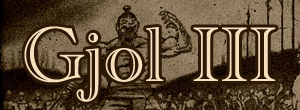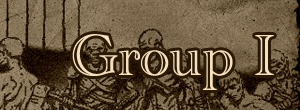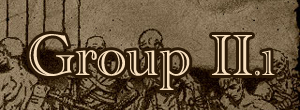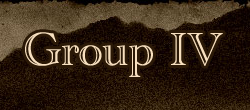Part 37: End of Act Three Bonus Video: Enunciation with Jade Star PLUS Corbeau and others play Gjol 3 and other Myth 2 maps

The following audio was recorded before the thread was posted. Everything you hear was recorded in one take, and is Jade Star's true and honest attempts to pronounce these words.

YouTube
Corbeau posted:
Guava and Myth 3 may be on hiatus, but the show shall continue. Guava just finished Rebellion, easily one of the brutal levels in any Myth campaign. I just finished calling it hard, but not that bad. It's time to explain why.
Across the Gjol was a classic map from Myth: The Fallen Lords. You defended a bluff from several waves of dark units from Soulblighter's army. It was a fun mission, if a tad static and easy. You had superb qualitative and terrain advantages to use against a numerically superior foe, and it's always fun to blow up waves of Thrall and Wights.
By the time 2004 rolled around, the only people still playing Myth cooperatively were experienced veterans of the Myth games. The campaign levels offered no real challenge anymore, even on Legendary, and particularly not an easy level like Across the Gjol. Enter a scripter called The Wolf. Wolf decided to update the classic fun feel of Across the Gjol, bringing it to Myth II and making it a challenge even for the best cooperative teams. I happened to know the guy at the time, and the memories of playtesting this map over and over again are seared into my brain.
Those memories, however, are happy ones. Unlike Rebellion, Gjol III is remarkably fair. The difficulty doesn't come from sheer power or overwhelming numbers, though the enemy certainly has that on higher difficulty settings. The real challenge of Gjol III comes from the carefully playtested scripting of each wave that is designed to put a few enemy units in the worst possible places for the players. Furthermore, though each wave has solutions, the length of the mission demands consistency. Every loss comes from mistakes, and, particularly on normal difficulty and below, no attack feels "cheap." It always feels like you could have beaten that next wave if only you'd played a little bit better. Combined with the fact that Gjol III randomly selects from a wide variety of creative enemy waves, the map is downright addictive.
In short, unlike Rebellion, Gjol III is well designed and well scripted. Now we're going to screw it all up with goon-style coop. Vaos and I played a few rounds tonight, and I intend to host a couple of Gjol coop nights during Guava's hiatus for anyone interested in playing. You'll need a copy of Myth II: Soulblighter, the version 1.71 patch from Project Magma, and a copy of the Gjol III plugin from The Tain. Oh, and you'll need to make a Marus.net account (which will also work for Myth 3, when Guava gets around to running public multiplayer).
Here's a demonstration of what we learned from tonight's session:
Gjol III - Introduction (featuring Vaos)
Specifically, we learned that goon coop should not be played on Legendary.
Corbeau posted:
Turns out that we shot a lot of footage last week. This is only the first game, edited down to "greatest hits" - there will be more coming later.
Corbeau posted:
Gjol 3 has several alternate unitset meshes, including a mesh where you use dark units against light attackers and a mesh designed for use with the Bushido tagset. The Bushido plugin changes vanilla Myth units into troops based on fantastical Japan. This is a video of how this plays out, and the rest of this post includes a unit rundown prior to the main videos. In general, Bushido is extremely fast and deadly compared to normal Myth.
Ashigaru Spearmen - Thrall analogs, Ashigaru are actually faster than most archery or artillery units (Ashigaru are as fast as vanilla Warriors) and have a much longer reach than other melee units. This makes them incredibly deadly en mass in ways that Thrall can never match. Ashigaru are much less vulnerable to kiting, and they'll beat other melee on a point-for-point basis. They're still slow for a Bushido unit, but their power is worthy of respect.
Warrior Monks - Ghol analogs, Monks are fast and damaging but very fragile. They'll melt against other melee units, but are good at shredding exposed archers or artillery.
Ronin - Warrior analogs, Ronin are thoroughly average for a Bushido melee unit. They're faster than vanilla Warriors, allowing them to outrun Ashigaru, but Ronin are also slower and fight worse than Samurai.
Samurai - Berserk analogs, Samurai are murder on a stick. They're fast and deadly, but also expensive. Each casualty hurts. Even worse, mass Ashigaru can outfight Samurai on a point-for-point basis, so they lack the universal melee superiority of vanilla Berserks.
Oni - Oni are Trow, save that they don't freeze into stone when heavily damaged.
Bowmen - These are vanilla Bowmen, fire arrow included, with two twists. First, this unit (or rather it's model) is the origin for the Gjol 3 fir'Bolg - meaning that Bushido Bowmen have that same irritatingly long attack animation that maximizes friendly fire. Second, Bushido Bowmen will throw shuriken at any range too close to shoot with a bow - even within melee. This makes Bowmen much more capable of defending themselves against one or two raiders in Bushido, though most Bushido melee units are faster and more deadly than their vanilla analogs.
Tengu - Tengu have no direct analog in vanilla, though I believe they replace Dwarves when the plugin is active. Tengu are faster than any melee unit, have see-through sprites while moving, and don't show up on enemy overhead maps during multiplayer matches. Their thrown area-of-effect projectiles do wildly varying damage, ranging from a minor inconvenience up to penalization or instant death. Tengu also carry four flowers that they can use to heal units like a Journeyman. Tengu are perfect for kiting and harassment, but require careful control due to their low health. Mistakes usually result in immediate death.
Rocket Mortars - Mortars, again, have no direct analog, though they're most akin to Dwarven Mortars. Mortars can lay satchel charges like Dwarves, but their attack is very different. Mortars launch a rocket with extreme range and substantial unreliability. Close range shots are quite reliable, but most long-range shots explode in the air during travel. Mortars are deadly and their range grants major tactical advantages, but they are also slow and extremely fragile. Mortars will demolish a passive player, but are extremely vulnerable to proactive play.
Elementalists - Fetch analogs, Elementalists are my favorite unit in Bushido. They have multiple standard attack spells depending on the range-to-target, and their special attack… you'll just have to watch the video.
And finally, Guavajitsu


















